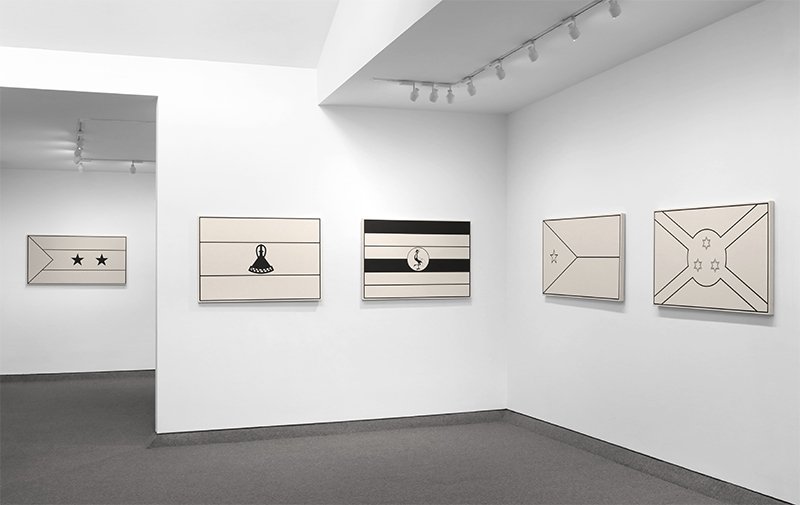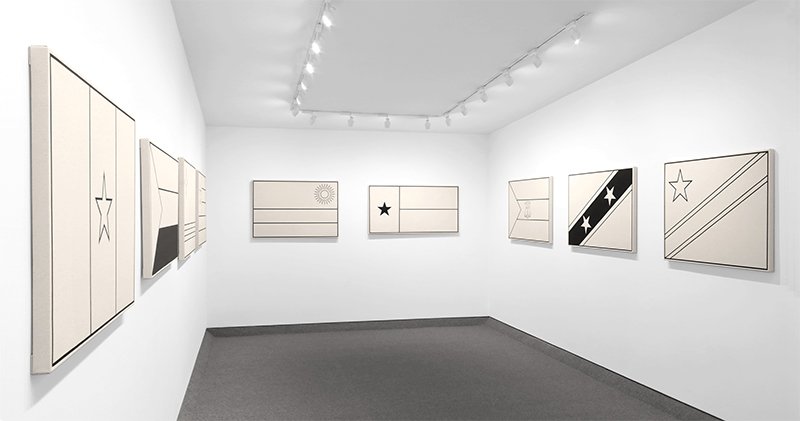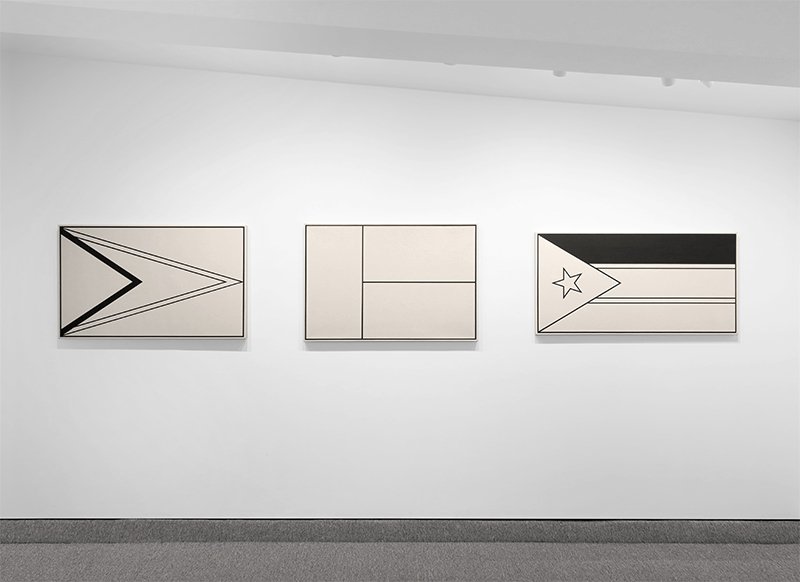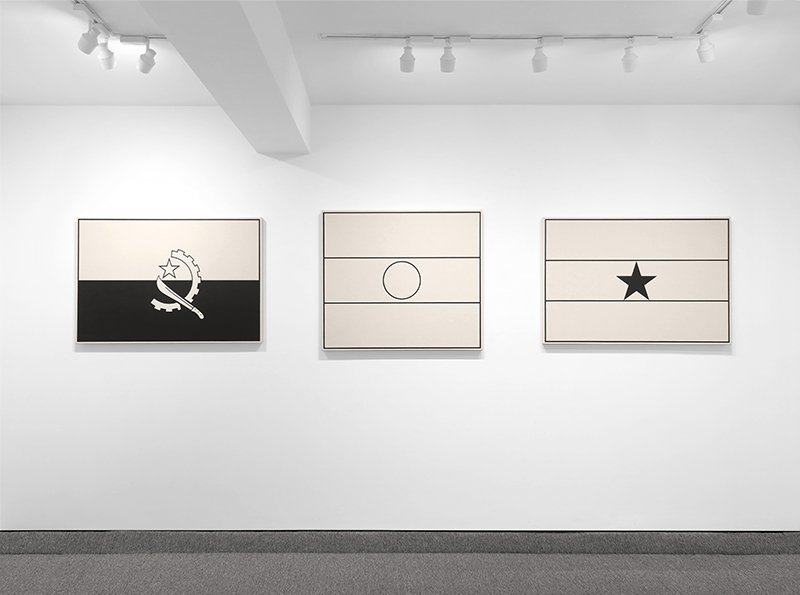
“Wilson’s project: the unpacking, deconstructing and reconfiguring of accepted cultural forms“
—Doro Globus
For the current exhibition, Fred Wilson has appropriated the designs of African and African diasporic countries’ flags to create paintings. The paintings are made from black acrylic paint (acrylic being a 20th century invention) on canvas made of cotton (one of the major early factors in the slave trade) with no color added, stretched on traditional stretcher bars. The speckled and creamy cotton of the canvas is unpainted, thus a site of permanent potential, perhaps a gesture towards the unfinished nature of nation-building or perhaps, as Reto Thüring conjectures, “the empty spaces … point to the blind spots in our own perceptions.” The artist, himself, states, “I feel the lack of color in the African Flag paintings expresses a feeling of loss–the loss of human potential in the wholesale theft and abuse of thousands of children and young adults abducted by slave traders.” He also says, “I was thinking about the nature of these countries–that they are unfinished and sometimes they change.” Recognizing that both of Wilson’s thoughts on his works are important, one understands that key to exploring Wilson’s work is an acceptance that the artist does not give nor expect definitive meanings. He is hoping for further questioning.
A short bit of info on the history of flags: In antiquity, “standards” (flag-like objects) were carried into battle. This most likely originated in ancient Egypt or Assyria. Rectilinear flags, held aloft from one side of the fabric, were used either in the Indian subcontinent or China. Their presence then spread to Southeast Asia and was subsequently transmitted to Europe through the Muslim world. Increased use of flags outside of the military context expanded with the rise of nationalist sentiments at the end of the 18th century. In the 19th and 20th centuries, political changes and social reforms, connected to growing senses of nationhood, led to the birth of new nations and thus new flags. Some nations’ flags have been particularly inspirational to other nations in the design of their own flags. The Soviet flag, with its golden symbols of the hammer and sickle on a red field, was an inspiration to flags of other communist states, including Mozambique. Some nations created flags similar to the United States’ so as to symbolize their similarity to the US and/or the American Revolution. Liberia is a prime example of this. Ethiopia was seen as a model by many emerging African states in the 1950s and 1960s, as it was one of the oldest independent countries in Africa. As such, its flag became the source of the “Pan-African colors”. Some examples include Benin, Ghana, Guinea, Mali, Senegal and Togo.
Flags are signs, symbols and also discrete objects. Among others, Jasper Johns explored this with his flag paintings. As seen with Johns’s paintings, when a symbol is altered, its reading is changed, sometimes making it more legible, sometimes less and sometimes just differently. For many of the countries represented in this exhibition, the flag designers thought about this, as well. They took familiar color combinations, patterns and/or shapes and made something new – something to express a new nation yet reference specific ideals (either pre-existing or new, and sometimes both). These signs, symbols, quotations and changes are legible to different degrees by different peoples. Wilson, by further altering the imagery of the flags, continues and confuses the lifecycles of the symbols. Like a still-life, landscape or portrait painting, Wilson’s works capture a moment in time mixed with all the signs, symbols and references of painting, picture-making and art history.
“Wilson’s work speaks to the realization that culture is almost never homogeneous and that cultural history seldom takes a linear course.”
—Reto Thüring



Edition of 3
23 3/4 x 46 1/8 inches (60.3 x 117.2 cm)
Signed and numbered on reverse
(Inventory #32653)
Edition of 3
23 3/4 x 46 1/8 inches (60.3 x 117.2 cm)
Signed and numbered on reverse
(Inventory #32653)
Edition of 3
27 1/4 x 40 1/8 inches (69.2 x 101.9 cm)
Signed and numbered on reverse
(Inventory #32632)
Edition of 3
27 1/4 x 40 1/8 inches (69.2 x 101.9 cm)
Signed and numbered on reverse
(Inventory #32632)

Edition of 3
23 5/8 x 46 1/8 inches (60 x 117.2 cm)
Signed and numbered
(Inventory #31787)
Edition of 3
23 5/8 x 46 1/8 inches (60 x 117.2 cm)
Signed and numbered
(Inventory #31787)

Edition of 3
27 1/8 x 40 1/8 inches (68.9 x 101.9 cm)
Signed and numbered on reverse
(Inventory #32633)
Edition of 3
27 1/8 x 40 1/8 inches (68.9 x 101.9 cm)
Signed and numbered on reverse
(Inventory #32633)
Edition of 3
27 1/8 x 40 inches (68.9 x 101.6 cm)
Signed and numbered on reverse
(Inventory #32652)
Edition of 3
27 1/8 x 40 inches (68.9 x 101.6 cm)
Signed and numbered on reverse
(Inventory #32652)
Edition of 3
27 1/8 x 40 1/8 inches (68.9 x 101.9 cm)
Signed and numbered on reverse
(Inventory #32657)
Edition of 3
27 1/8 x 40 1/8 inches (68.9 x 101.9 cm)
Signed and numbered on reverse
(Inventory #32657)

Edition of 3
25 3/4 x 42 1/8 inches (65.4 x 107 cm)
Signed and numbered
(Inventory #31790)
Edition of 3
25 3/4 x 42 1/8 inches (65.4 x 107 cm)
Signed and numbered
(Inventory #31790)
Edition of 3
23 5/8 x 46 1/8 inches (60 x 117.2 cm)
Signed and numbered on reverse
(Inventory #32635)
Edition of 3
23 5/8 x 46 1/8 inches (60 x 117.2 cm)
Signed and numbered on reverse
(Inventory #32635)
Edition of 3
27 1/8 x 40 1/8 inches (68.9 x 101.9 cm)
Signed and numbered on reverse
(Inventory #32658)
Edition of 3
27 1/8 x 40 1/8 inches (68.9 x 101.9 cm)
Signed and numbered on reverse
(Inventory #32658)
Edition of 3
27 1/8 x 40 inches (68.9 x 101.6 cm)
Signed and numbered on reverse
(Inventory #32634)
Edition of 3
27 1/8 x 40 inches (68.9 x 101.6 cm)
Signed and numbered on reverse
(Inventory #32634)

Edition of 3
23 5/8 x 46 1/8 inches (60 x 117.2 cm)
Signed and numbered on reverse
(Inventory #32660)
Edition of 3
23 5/8 x 46 1/8 inches (60 x 117.2 cm)
Signed and numbered on reverse
(Inventory #32660)
Edition of 3
27 1/4 x 40 1/8 inches (69.2 x 101.9 cm)
Signed and numbered
(Inventory #31786)
Edition of 3
27 1/4 x 40 1/8 inches (69.2 x 101.9 cm)
Signed and numbered
(Inventory #31786)
Edition of 3
27 1/8 x 40 1/8 inches (68.9 x 101.9 cm)
Signed and numbered on reverse
(Inventory #32656)
Edition of 3
27 1/8 x 40 1/8 inches (68.9 x 101.9 cm)
Signed and numbered on reverse
(Inventory #32656)


Edition of 3
27 x 40 inches (68.6 x 101.6 cm)
Signed and numbered on reverse
(Inventory #32637)
Edition of 3
27 x 40 inches (68.6 x 101.6 cm)
Signed and numbered on reverse
(Inventory #32637)
Edition of 3
23 7/8 x 46 1/8 inches (60.6 x 117.2 cm)
Signed and numbered on reverse
(Inventory #32647)
Edition of 3
23 7/8 x 46 1/8 inches (60.6 x 117.2 cm)
Signed and numbered on reverse
(Inventory #32647)
Edition of 3
27 x 40 inches (68.6 x 101.6 cm)
Signed and numbered on reverse
(Inventory #32654)
Edition of 3
27 x 40 inches (68.6 x 101.6 cm)
Signed and numbered on reverse
(Inventory #32654)

Edition of 3
27 x 40 inches (68.6 x 101.6 cm)
Signed and numbered on reverse
(Inventory #32646)
Edition of 3
27 x 40 inches (68.6 x 101.6 cm)
Signed and numbered on reverse
(Inventory #32646)
Edition of 3
28 5/8 x 37 3/4 inches (72.7 x 95.9 cm)
Signed and numbered on reverse
(Inventory #32641)
Edition of 3
28 5/8 x 37 3/4 inches (72.7 x 95.9 cm)
Signed and numbered on reverse
(Inventory #32641)


Edition of 3
25 5/8 x 42 inches (65.1 x 106.7 cm)
Signed and numbered on reverse
(Inventory #32650)
Edition of 3
25 5/8 x 42 inches (65.1 x 106.7 cm)
Signed and numbered on reverse
(Inventory #32650)
Edition of 3
27 1/8 x 40 1/8 inches (68.9 x 101.9 cm)
Signed and numbered on reverse
(Inventory #32640)
Edition of 3
27 1/8 x 40 1/8 inches (68.9 x 101.9 cm)
Signed and numbered on reverse
(Inventory #32640)
Edition of 3
23 5/8 x 46 1/8 inches (60 x 117.2 cm)
Signed and numbered on reverse
(Inventory #32638)
Edition of 3
23 5/8 x 46 1/8 inches (60 x 117.2 cm)
Signed and numbered on reverse
(Inventory #32638)


Edition of 3
27 x 40 inches (68.6 x 101.6 cm)
Signed and numbered on reverse
(Inventory #32659)
Edition of 3
27 x 40 inches (68.6 x 101.6 cm)
Signed and numbered on reverse
(Inventory #32659)
Edition of 3
30 1/8 x 35 inches (76.5 x 88.9 cm)
Signed and numbered
(Inventory #31794)
Edition of 3
30 1/8 x 35 inches (76.5 x 88.9 cm)
Signed and numbered
(Inventory #31794)
Edition of 3
27 1/4 x 40 1/8 inches (69.2 x 101.9 cm)
Signed and numbered on reverse
(Inventory #32631)
Edition of 3
27 1/4 x 40 1/8 inches (69.2 x 101.9 cm)
Signed and numbered on reverse
(Inventory #32631)

Edition of 3
27 1/8 x 40 1/8 inches (68.9 x 101.9 cm)
Signed and numbered on reverse
(Inventory #32662)
Edition of 3
27 1/8 x 40 1/8 inches (68.9 x 101.9 cm)
Signed and numbered on reverse
(Inventory #32662)
Edition of 3
27 1/8 x 40 1/8 inches (68.9 x 101.9 cm)
Signed and numbered on reverse
(Inventory #32655)
Edition of 3
27 1/8 x 40 1/8 inches (68.9 x 101.9 cm)
Signed and numbered on reverse
(Inventory #32655)

Edition of 3
23 5/8 x 46 1/8 inches (60 x 117.2 cm)
Signed and numbered on reverse
(Inventory #32651)
Edition of 3
23 5/8 x 46 1/8 inches (60 x 117.2 cm)
Signed and numbered on reverse
(Inventory #32651)

Edition of 3
27 1/8 x 40 1/8 inches (68.9 x 101.9 cm)
Signed and numbered
(Inventory #31791)
Edition of 3
27 1/8 x 40 1/8 inches (68.9 x 101.9 cm)
Signed and numbered
(Inventory #31791)
Edition of 3
27 1/8 x 40 1/8 inches (68.9 x 101.9 cm)
Signed and numbered
(Inventory #31789)
Edition of 3
27 1/8 x 40 1/8 inches (68.9 x 101.9 cm)
Signed and numbered
(Inventory #31789)
Edition of 3
27 x 40 inches (68.6 x 101.6 cm)
Signed and numbered on reverse
(Inventory #32661)
Edition of 3
27 x 40 inches (68.6 x 101.6 cm)
Signed and numbered on reverse
(Inventory #32661)
Edition of 3
27 1/8 x 40 1/8 inches (68.9 x 101.9 cm)
Signed and numbered
(Inventory #31793)
Edition of 3
27 1/8 x 40 1/8 inches (68.9 x 101.9 cm)
Signed and numbered
(Inventory #31793)
Edition of 3
27 1/8 x 40 1/8 inches (68.9 x 101.9 cm)
Signed and numbered on reverse
(Inventory #32636)
Edition of 3
27 1/8 x 40 1/8 inches (68.9 x 101.9 cm)
Signed and numbered on reverse
(Inventory #32636)
Edition of 3
25 7/8 x 42 1/8 inches (65.7 x 107 cm)
Signed and numbered on reverse
(Inventory #32642)
Edition of 3
25 7/8 x 42 1/8 inches (65.7 x 107 cm)
Signed and numbered on reverse
(Inventory #32642)
Edition of 3
27 1/8 x 40 1/8 inches (68.9 x 101.9 cm)
Signed and numbered on reverse
(Inventory #32643)
Edition of 3
27 1/8 x 40 1/8 inches (68.9 x 101.9 cm)
Signed and numbered on reverse
(Inventory #32643)
Edition of 3
27 x 40 inches (68.6 x 101.6 cm)
Signed and numbered on reverse
(Inventory #32644)
Edition of 3
27 x 40 inches (68.6 x 101.6 cm)
Signed and numbered on reverse
(Inventory #32644)
Edition of 3
27 1/8 x 40 1/8 inches (68.9 x 101.9 cm)
Signed and numbered on reverse
(Inventory #32645)
Edition of 3
27 1/8 x 40 1/8 inches (68.9 x 101.9 cm)
Signed and numbered on reverse
(Inventory #32645)
Edition of 3
27 1/4 x 40 1/8 inches (69.2 x 101.9 cm)
Signed and numbered on reverse
(Inventory #32648)
Edition of 3
27 1/4 x 40 1/8 inches (69.2 x 101.9 cm)
Signed and numbered on reverse
(Inventory #32648)
Edition of 3
27 x 40 inches (68.6 x 101.6 cm)
Signed and numbered on reverse
(Inventory #32649)
Edition of 3
27 x 40 inches (68.6 x 101.6 cm)
Signed and numbered on reverse
(Inventory #32649)
No results found.
10 Newbury Street, Boston, Massachusetts 02116
617-262-4490 | info@krakowwitkingallery.com
The gallery is free and open to the public. Please note our summer schedule:
June
Tuesday – Saturday, 10–5:30
(Open on Juneteenth)
July 1–25
Tuesday – Friday, 10–5:30
(Closed Friday, July 4)
July 29 – September 1
Open via appointment
Beginning September 2
Tuesday – Saturday, 10–5:30